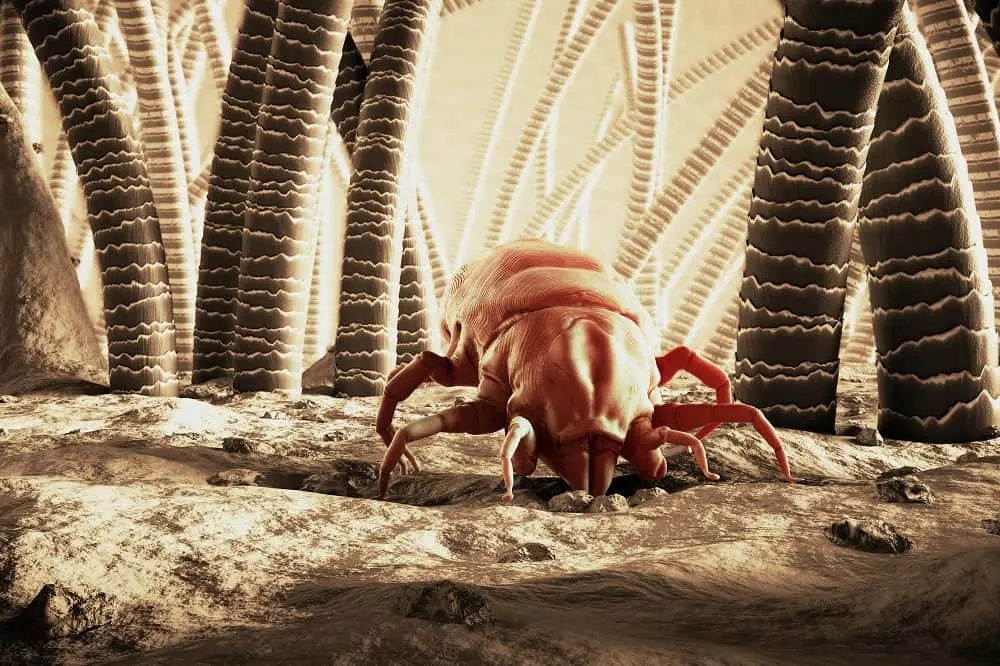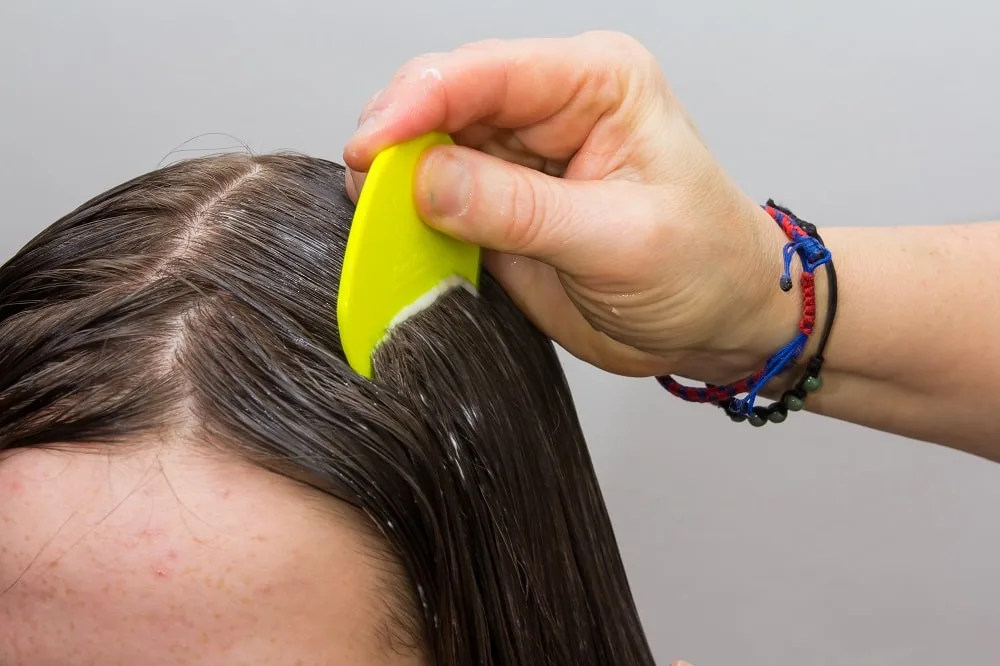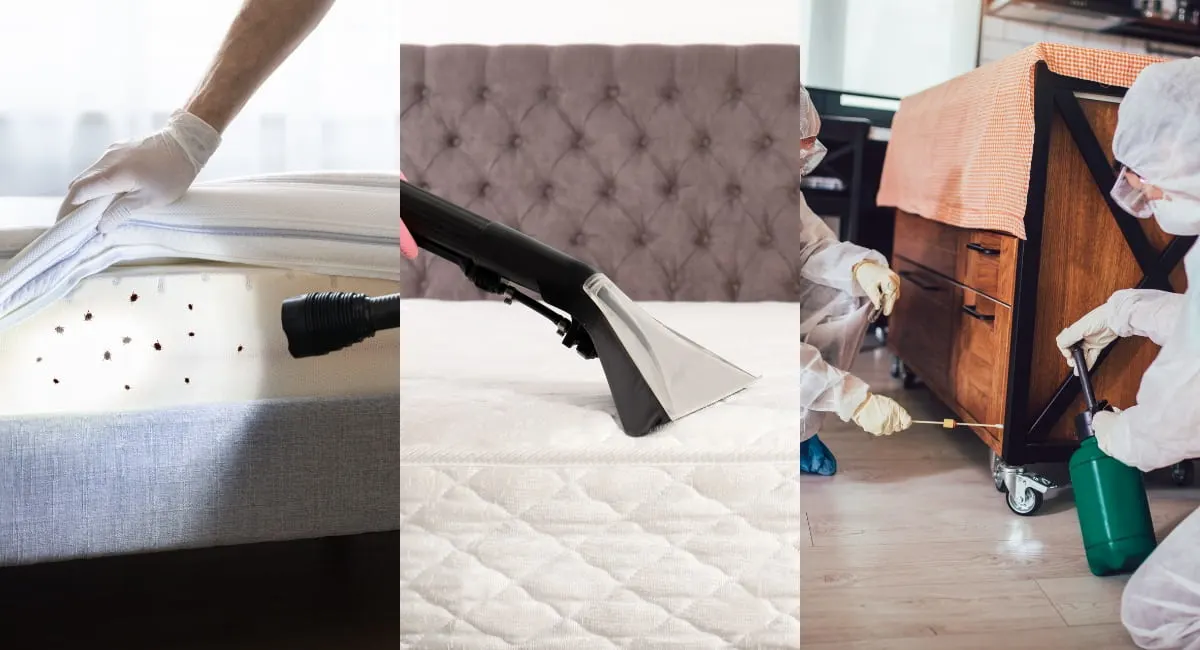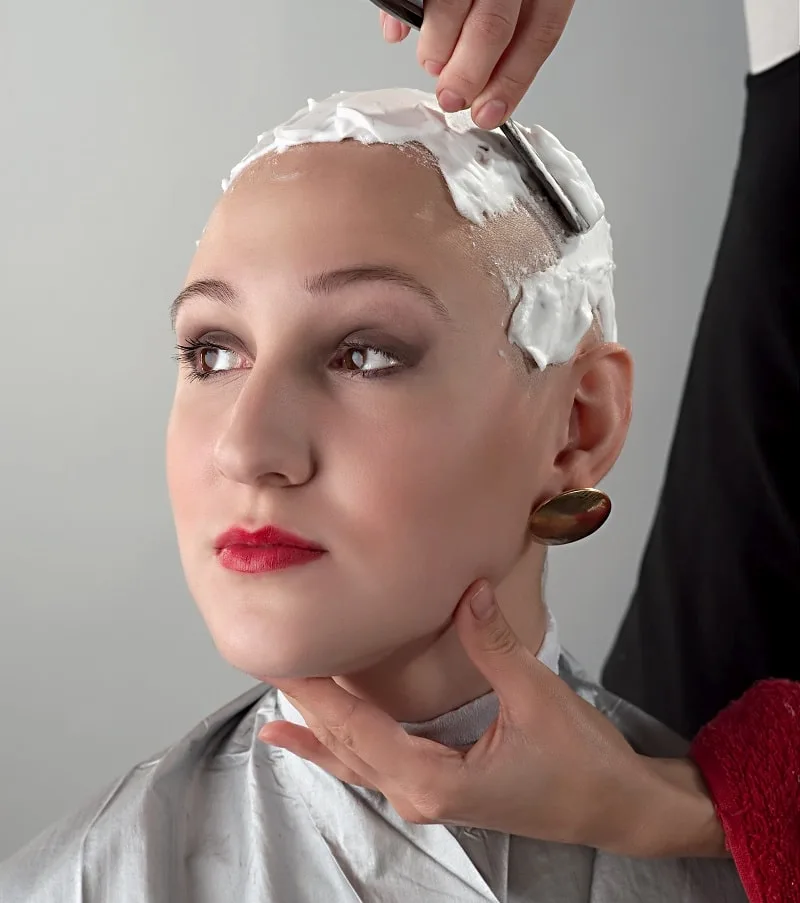Bed bugs are probably some of the most disgusting pests around to ever exist, and you’ve probably heard of them too. Bed bugs are pesky creatures that love to bite humans and feed on their blood.
They can easily live without a meal for six to fourteen months and they are unbelievably skilled at surviving by hiding in nooks and crannies and multiplying at amazing speeds.
As such, they are easily able to spread from one unit to another which is why it is typical to find bed bugs at hotels and motels, apartment complexes, airplanes, buses, and other places where it is common for humans to pass through. This is also why it is so hard to eliminate bed bugs as well.
In this article, we will talk about how to remove bed bugs from your hair and other related health tips and general advice on these pests, and how to remove them from your vicinity as well.
Can Bed Bugs Live In Your Hair

If you’ve found bed bugs in your hair or bed bug bite marks on your scalp and skin then it might be a comfort for you to know that bed bugs can’t live in your hair.
Unlike lice and mites, bed bugs lack the proper biological parts that allow the former pests to travel through and around the hair. This is a disadvantage for bed bugs and as a result, they avoid making a home there.
Bed bugs like to reside in areas where there is negligible movement, which makes them more averse to human hair or the human body.
However, bed bugs do like feeding on human blood by biting through the skin, and the scalp is one of the softest skin on the human body making it easy for bed bugs to feed on human blood and an advantageous location as well.
Therefore, bed bugs typically get on your hair while you’re asleep as that is the time they can feed on with minimal disturbance. After they’re done feeding, they simply go back to their dwellings leaving the human they fed on with bite marks.
Related: Can fleas hide and live in human hair?
How To Know If Your Hair Has Bed Bugs
You can check your hair for bed bugs by looking for bite marks along your scalp line. Sometimes, you may be able to feel them crawling around in your hair as well.
If you find bed bugs in your hair or bed bug bites on your body, your house or living quarters are likely infested as well. Given the extent of the infestation, it is completely possible to have their eggs in your hair as well. While this thought may be abhorring, you should remain vigilant to see if bed bug eggs are in your hair.
It’s also quite common for people to dismiss the early signs of a bed bug infestation as bite marks from bed bugs resemble a lot to mosquito bites. A bed bug population can multiply every 16 days.
As the hair is not the ideal environment for bed bugs to live in they tend to move to cooler and darker places where it is harder to spot them. This is why it is so important to catch an infestation before it explodes to the whole house, or worse, the whole apartment.
The best way to find out if you have bed bugs in your house is to set up traps that can allow you to catch a few of those pesky little pets. More details about how to set up traps to catch bed bugs in your house are provided in the FAQ section below.
How To Remove Bed Bugs From Your Hair

As mentioned before, bed bugs don’t live in your hair. They feed on human blood by biting into the skin and while they prefer bare skin, the scalp is one of their go-to places as the skin on the scalp is the softest on the human body.
If you do find bed bugs on your hair, your house is likely infested. And even though there are steps you can take to remove bed bugs from your hair, removing bed bugs from your house is a completely different story.
While we’ll investigate more specific options to remove bed bugs from your hair, here is a more simple and general approach to it.
A simple and general approach to removing bed bugs from hair:
- Apply Neem oil, lice shampoo, or 91% rubbing alcohol with your shampoo and apply it to your scalp. We would suggest experimenting by combining all three of the options with your shampoo separately and seeing what works best for you.
- After that, you should leave the shampoo on your head for 15 to 20 minutes. Then rinse out the shampoo from your hair with warm or hot water. Bed bugs can’t survive over temperatures of 118°F so hot water can easily kill them off.
- Then, comb your hair using a nit comb that is specifically designed to remove bed bugs from your hair.
- Wash off the bed bugs from your hair and then rinse the comb with warm water.
- Keep combing your hair until you’re satisfied that you’ve removed all the bed bugs from your hair.
- Repeat the whole process every two days until the bed bugs are gone.
While this general approach does work in most cases, since your home is likely infested with bed bugs, the bugs will keep coming back. This is why we need to look into more specific and permanent solutions that include not just treating your hair but also treating your house.
More Specific Ways To Get Rid of Bed Bugs From Your Hair
We’re going to start with the best methods to rid yourself of the pesky bugs. They may not be the easiest or the most comfortable options, but most of these options are guaranteed to help with your problem.
1. Home Treatments

As stated previously, bed bugs in your hair mean there is a full-blown infestation in your home. At the least, your bed and the surrounding area contain bed bugs. Typically, they’re hiding in the crevices of your bed and the vicinity during the day and coming out to feast during the night. Removing bed bugs from your hair won’t do much if you don’t remove the infestation in your home.
Check every corner of the bed, the headboard if you have one, picture frames, and other nooks and crannies. Also, check your sheets and pillows as some of those pests may be there as well.
To remove bed bugs from your home start with washing all your sheets, comforters, pillowcases, and other bedding materials. Try adding all your clothes that you’re not wearing into the laundry as well, as bed bugs can hide there too. Set your washing machine to a hot water setting and include bleach with your detergent.
After washing your bedding materials and clothes is complete, dry them at the highest settings. According to a paper in the Journal of Economic Entomology, heat and localized heat treatment has lethal effects on controlling and eliminating bed bug infestations.
Drying at the highest heat setting will exterminate any surviving bed bugs from the washing machine. Then vacuum your room, beds, mattresses, and the surrounding area. You can also wrap all the mattresses afterward to stop more bed bugs to migrate to your mattress while the extermination process is taking place.
You can also apply rubbing alcohol or bed bug powder to the box springs. Make sure to steam all your bedding items before placing them back to their original places as well as steam the surrounding areas.
Of course, all of this sounds a lot, and in most cases unmanageable for a normal person. You probably won’t even have the right tools to do some of these activities.
Therefore, it would be wise to call professional pest control to eliminate bed bugs from your house but remember that not removing the infestation from your house will result in more bed bugs in your hair.
It is also quite likely that the infestation has probably spread to other units if you’re living in an apartment complex. Professional pest control agencies will be able to help you and others to identify it.
2. Heat Treatment
You can easily sit in a sauna where the temperature typically ranges from 117°F to 122°F. This is the ideal temperature to kill off any bed bug that may be in your hair as well as their eggs. This step should of course be used with caution.
If you can’t avail of the services of a sauna, a hot shower should suffice. As mentioned previously, wash your hair with a shampoo of your choice, rubbing it all over the scalp and hair. Then, rinse your hair with hot water and comb through the hair to remove the dead bugs and their eggs.
You can also use a steamer although remain cautious while using one and follow the appropriate instructions on how to use a steamer at a safe temperature for yourself but lethal for the bugs.
3. Apply Cedar Oil
Cedar oil or any product containing cedar oil is always helpful when dealing with bed bugs. Include a few drops of the oil into your body wash, shampoo, and conditioner. However, keep in mind that cedar oil may cause some itching or discomfort on the scalp as well.
4. Shave Your Head

While we recognize this may not be a viable option for many if you’re able to go completely bald you should go for it.
This is an effective solution as shaving your head removes the hair as a hiding spot for the bed bugs. With the scalp being exposed, bed bugs tend to stray away from the head as it leads to them being easily spotted.
5. Use Lice Shampoo/Treatment
While bed bugs are completely different from lice, lice treatment, such as a shampoo or lotion designed to kill lice, is proven to remove bed bugs and their eggs.
Once you’ve purchased a lice shampoo or a lice treatment kit, follow the instructions that come with it to apply it to your hair as each product is different.
Typically, you should leave the lice shampoo on your hair for a few minutes after applying it and comb your hair with a nit comb once you’ve rinsed off all of it. Nit combs are specifically designed to remove bed bugs from your hair.
You should repeat this process every few days until all the bed bugs and their eggs are eliminated.
6. Use Alcohol
You can mix some rubbing alcohol with your shampoo and rub it in your hair and scalp. Follow the same process described above after rinsing your hair and repeat the process every few days.
A word of caution, alcohol can negatively affect your hair, causing it to dry out and cause damage. To stop that from happening, you could introduce a moisturizing shampoo and conditioner to the mix.
7. Use Oil and A Shower Cap

You can use mineral oils or olive oils on your hair and scalp as well. Once you’ve applied the oil, use a shower cap to cover up your hair and leave it overnight.
This will suffocate the bed bugs in your hair by the time its morning. After that, you can just shampoo your hair and comb through it as described previously to remove all the dead bed bugs.
8. Throw Away Headpieces
Throw away any wigs or hairpieces that you may have lying around in the house as those are also likely infested and may cause further problems in ridding yourself of the little pests.
Frequently Asked Questions
Bed bugs are small, brownish insects that feed on the blood of warm-blooded animals. While they typically feed on humans, they also tend to make a meal out of dogs, birds, bears, and rodents.
The earliest mention of bed bugs can be traced back to some medieval European texts and even classical Greek writings. The bed bug population had mostly died off before it made a huge comeback around the 2000s in the US and around the world.
This sudden rise in bed bug population was caused for multiple reasons, including less potent insecticides or a rise in tolerance towards said insecticides by the bed bugs, a rise in global travel, and a decrease in awareness and vigilance towards bed bugs.
Bed bugs can survive for months without even having to feed themselves and can easily multiply in numbers which can result in them spreading through a large area comparatively quickly. This is why abandoning the place of infestation in thoughts of starving the bugs won’t work.
Bed bugs are small insects reddish-brown in color, around 3/16-inch in length, with oval and flattened bodies, and have six legs. They’re so thin they can fit into credit cardholders.
They are similar in color to an apple seed but are almost the size of a single piece of lentil. Younger bed bugs, also known as nymphs, resemble adults but they are also smaller and lighter in color.
Newly born nymphs are straw-colored and about the size of a pinhead. As they grow, they start shedding their skin, which happens five times before they reach adulthood. During this shedding, the nymphs feed off of blood.
No, bed bugs cannot fly or jump. However, because of their size, they can easily hide in small crevices and can crawl extremely fast across any kind of surface.
Adult female bed bugs lay eggs in secluded places. They can lay multiple eggs per day and hundreds in their lifetime. Adult females can also feed on warm-blooded animals to lay eggs.
The eggs are about the size of the speck of dust, white in color, and incredibly hard to see without magnification. They are sticky when they are initially laid and easily stick to surfaces.
It takes about a week for these eggs to hatch at room temperature. If nymphs have access to a supply of blood, they can grow mature in almost a month and multiply in numbers.
Bed bugs will typically bite on any bare skin they can find. The less hair on a body, the better for them as like other insects or pests they lack the appendages needed to traverse through hair.
But bed bugs can also be more likely to bite your neck, face, and head area than the legs and arms.
Bites from bed bugs will usually look like a red welt that is extremely itchy and irritating. The welts can also bleed and appear in small dots in groups in a specific part of your body. Sometimes you may also notice a raised center around the affected area.
Some people can also get allergic reactions to the bites besides the small dots is also worth mentioning. There can also be cases where victims may experience nausea, fever, blisters, and difficulty in breathing.
While bugs can carry leprosy, Q-fever, brucellosis, and other diseases, they do not spread those diseases to humans or any other warm-blooded animals according to a paper written by Dolling WR in 1991.
A Sheffield University study found that bed bugs are deterred by longer hairs as it can slow them down from feeding on open skin and longer hair can also alert the hosts faster than shorter hair.
Contrary to popular belief, bed bugs are not capable of living in a person’s hair as they cannot move through hair due to not having the proper biological parts and they like places that are dormant making a human head not the ideal place to live in.
They do tend to live in dark, secluded places where the temperature is typically colder than room temperature. They hide in small crevices on your bed, behind furniture, walls, or within the cracks of floorboards.
Bed bugs come out of these hiding spots during the night, to feed on their hosts. If you sleep during the day, then the bugs will adapt to your sleep schedule as you’re one of the sources for their food.
Bed bugs don’t have anything to do with being clean or hygienic. Bed bugs can easily thrive in clean environments.
While there are endless possibilities, bed bugs can come from an infested hairpiece, an infested bus/train/airplane, your luggage and clothes that you’re not wearing that you’ve taken on your travels, infested hair equipment, another infested home, infested hotels or motels.
As you can understand, bed bugs can easily travel from one infested region to another region where they can easily multiply. If you’ve unknowingly stumbled upon an infested area or object you might have a bed bug problem in your home.
Bed bugs signs include finding small blood stains on your sheets, pillowcases, or the sides and crevices of the bed.
You may also see some dark and rusty spots on walls or carpets. There can also be a strong but sweet, musky odor in areas that are infested.
We’ve mentioned before that you should definitely check your bed, headboards, floorboards, and the surrounding areas of your bed but you should also check chairs, couches, cushions, folds of curtains, drawer joints, electrical outlets, and appliances, between walls and ceilings, and any tiny, thin areas in your home that are protected and are expected to be darker and with cooler temperatures.
If you have been traveling, been to the hospital, or in any place that you suspect of being infested, you should also check your bags, luggage, and even clothes that you have traveled with.
You can also find a dish-shaped trap that is placed under the legs of beds, tables, and sofas that help trap bed bugs while they travel to and from their hiding spots to feed on you during your sleep. These dishes can stop the bed bugs from escaping to their hiding spots easily.
Conclusion
In conclusion, bed bugs are an absolute nightmare and can not only affect you physically but can also be exhausting mentally. Just to be safe, always check any hotel rooms you travel to and keep your luggage as secluded as possible.
There’s honestly no way of knowing beforehand but it’s always best to know as much you can about bed bugs, the signs to look for, and how to get rid of them. So have you had any experiences with bed bugs recently? Let us know.
